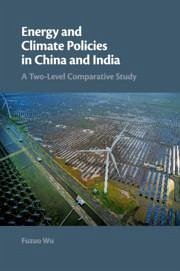Fuzuo Wu
Energy and Climate Policies in China and India
Fuzuo Wu
Energy and Climate Policies in China and India
- Broschiertes Buch
Andere Kunden interessierten sich auch für
![Abortion Politics in Congress Abortion Politics in Congress]() Scott H AinsworthAbortion Politics in Congress33,99 €
Scott H AinsworthAbortion Politics in Congress33,99 €![The Economic Accomplices to the Argentine Dictatorship The Economic Accomplices to the Argentine Dictatorship]() The Economic Accomplices to the Argentine Dictatorship50,99 €
The Economic Accomplices to the Argentine Dictatorship50,99 €![Curbing the Court Curbing the Court]() Brandon L BartelsCurbing the Court42,99 €
Brandon L BartelsCurbing the Court42,99 €![Policy Accumulation and the Democratic Responsiveness Trap Policy Accumulation and the Democratic Responsiveness Trap]() Christian AdamPolicy Accumulation and the Democratic Responsiveness Trap45,99 €
Christian AdamPolicy Accumulation and the Democratic Responsiveness Trap45,99 €![Insiders Talk Insiders Talk]() Robert L GuyerInsiders Talk46,99 €
Robert L GuyerInsiders Talk46,99 €![Greek Corporate Governance Legislation Greek Corporate Governance Legislation]() John Anthony O'SheaGreek Corporate Governance Legislation51,99 €
John Anthony O'SheaGreek Corporate Governance Legislation51,99 €![The Generous Prenup The Generous Prenup]() Laurie IsraelThe Generous Prenup21,99 €
Laurie IsraelThe Generous Prenup21,99 €-
-
-
Produktdetails
- Verlag: Cambridge University Press
- Seitenzahl: 330
- Erscheinungstermin: 26. März 2020
- Englisch
- Abmessung: 229mm x 152mm x 18mm
- Gewicht: 445g
- ISBN-13: 9781108816311
- ISBN-10: 1108816312
- Artikelnr.: 59353441
Hinweis: Dieser Artikel kann nur an eine deutsche Lieferadresse ausgeliefert werden.
- Herstellerkennzeichnung
- Libri GmbH
- Europaallee 1
- 36244 Bad Hersfeld
- gpsr@libri.de
Fuzuo Wu is an Assistant Professor at Aalborg University, Denmark. She holds a Ph.D. in International Relations from Fudan University, and was a postdoctoral researcher at Princeton University, the University of Oxford, and Yale University; a Visiting Senior Research Fellow at Lee Kuan Yew School of Public Policy, National University of Singapore; a Research Fellow at Center for Chinese Foreign Policy Studies at Fudan University; and a Junior Research Fellow at the Institute of South Asian Studies at Sichuan University, China. She has published a book in Chinese and a few articles in peer-reviewed journals, such as the Journal of Contemporary China, Asian Survey, Asian Perspective, and the Journal of Chinese Political Science.
Part I. Introduction and Analytical Framework: 1. Introduction
1.1. China and India's puzzling energy and climate policy behavior
1.2. Argument in brief and propositions
1.3. Literature review: levels of analysis
1.4. Case selection
1.5. Contributions of the book
1.6. Structure of the book
2. Shaping China and India's energy and climate policy behavior: wealth, status and asymmetrical interdependence
2.1. China and India: proactive and reactive state actors
2.2. Two-level pressures: wealth, status, and asymmetrical interdependence
2.3. Conclusion
Part II. The Inside-Out: 3. China and India's domestic energy policy: proactive
3.1. Energy security: a top priority for China and India
3.2. China and India's proactive domestic measures to procure energy security
3.3. Differences between China and India's domestic energy policy approaches
3.4. Conclusion
4. China and India's energy diplomacy: proactively preempting and reactively restraining
4.1. China and India's energy diplomacy: proactive and reactive
4.2. China and India's energy diplomacy toward Iran
4.3. China and India's energy diplomacy toward Sudan
4.4. China and India's energy diplomacy toward Myanmar
4.5. Comparison of the three cases
4.6. Shaping China and India's energy diplomacy: two-level pressures
4.7. Conclusion
Part III. The Outside-In: 5. China and India negotiating climate change: proactively free-riding and reactively burden sharing
5.1. China and India's dual-track climate diplomacy
5.2. Compromises under duel-track climate diplomacy
5.3. Shaping China and India's climate diplomacy: two-level pressures
5.4. Conclusion
6. China and India's domestic climate policy: reactive
6.1. Pressures from epistemic communities to address climate change
6.2. China and India's reactive domestic policy measures to address climate change
6.3. China and India subordinating climate change to energy security
6.4. Shaping Sino-Indian domestic energy and climate policy: two-level pressures
6.5. Conclusion
Part IV. Implications and Conclusion: 7. Implications for global energy and climate governance
7.1. Global energy and climate governance
7.2. Implications of Sino-India addressing energy insecurity and climate change for global energy and climate governance
7.3. Conclusion
8. Conclusion
8.1. Principal findings
8.2. Implications for international relations research
8.3. Understanding China and India's rise.
1.1. China and India's puzzling energy and climate policy behavior
1.2. Argument in brief and propositions
1.3. Literature review: levels of analysis
1.4. Case selection
1.5. Contributions of the book
1.6. Structure of the book
2. Shaping China and India's energy and climate policy behavior: wealth, status and asymmetrical interdependence
2.1. China and India: proactive and reactive state actors
2.2. Two-level pressures: wealth, status, and asymmetrical interdependence
2.3. Conclusion
Part II. The Inside-Out: 3. China and India's domestic energy policy: proactive
3.1. Energy security: a top priority for China and India
3.2. China and India's proactive domestic measures to procure energy security
3.3. Differences between China and India's domestic energy policy approaches
3.4. Conclusion
4. China and India's energy diplomacy: proactively preempting and reactively restraining
4.1. China and India's energy diplomacy: proactive and reactive
4.2. China and India's energy diplomacy toward Iran
4.3. China and India's energy diplomacy toward Sudan
4.4. China and India's energy diplomacy toward Myanmar
4.5. Comparison of the three cases
4.6. Shaping China and India's energy diplomacy: two-level pressures
4.7. Conclusion
Part III. The Outside-In: 5. China and India negotiating climate change: proactively free-riding and reactively burden sharing
5.1. China and India's dual-track climate diplomacy
5.2. Compromises under duel-track climate diplomacy
5.3. Shaping China and India's climate diplomacy: two-level pressures
5.4. Conclusion
6. China and India's domestic climate policy: reactive
6.1. Pressures from epistemic communities to address climate change
6.2. China and India's reactive domestic policy measures to address climate change
6.3. China and India subordinating climate change to energy security
6.4. Shaping Sino-Indian domestic energy and climate policy: two-level pressures
6.5. Conclusion
Part IV. Implications and Conclusion: 7. Implications for global energy and climate governance
7.1. Global energy and climate governance
7.2. Implications of Sino-India addressing energy insecurity and climate change for global energy and climate governance
7.3. Conclusion
8. Conclusion
8.1. Principal findings
8.2. Implications for international relations research
8.3. Understanding China and India's rise.
Part I. Introduction and Analytical Framework: 1. Introduction
1.1. China and India's puzzling energy and climate policy behavior
1.2. Argument in brief and propositions
1.3. Literature review: levels of analysis
1.4. Case selection
1.5. Contributions of the book
1.6. Structure of the book
2. Shaping China and India's energy and climate policy behavior: wealth, status and asymmetrical interdependence
2.1. China and India: proactive and reactive state actors
2.2. Two-level pressures: wealth, status, and asymmetrical interdependence
2.3. Conclusion
Part II. The Inside-Out: 3. China and India's domestic energy policy: proactive
3.1. Energy security: a top priority for China and India
3.2. China and India's proactive domestic measures to procure energy security
3.3. Differences between China and India's domestic energy policy approaches
3.4. Conclusion
4. China and India's energy diplomacy: proactively preempting and reactively restraining
4.1. China and India's energy diplomacy: proactive and reactive
4.2. China and India's energy diplomacy toward Iran
4.3. China and India's energy diplomacy toward Sudan
4.4. China and India's energy diplomacy toward Myanmar
4.5. Comparison of the three cases
4.6. Shaping China and India's energy diplomacy: two-level pressures
4.7. Conclusion
Part III. The Outside-In: 5. China and India negotiating climate change: proactively free-riding and reactively burden sharing
5.1. China and India's dual-track climate diplomacy
5.2. Compromises under duel-track climate diplomacy
5.3. Shaping China and India's climate diplomacy: two-level pressures
5.4. Conclusion
6. China and India's domestic climate policy: reactive
6.1. Pressures from epistemic communities to address climate change
6.2. China and India's reactive domestic policy measures to address climate change
6.3. China and India subordinating climate change to energy security
6.4. Shaping Sino-Indian domestic energy and climate policy: two-level pressures
6.5. Conclusion
Part IV. Implications and Conclusion: 7. Implications for global energy and climate governance
7.1. Global energy and climate governance
7.2. Implications of Sino-India addressing energy insecurity and climate change for global energy and climate governance
7.3. Conclusion
8. Conclusion
8.1. Principal findings
8.2. Implications for international relations research
8.3. Understanding China and India's rise.
1.1. China and India's puzzling energy and climate policy behavior
1.2. Argument in brief and propositions
1.3. Literature review: levels of analysis
1.4. Case selection
1.5. Contributions of the book
1.6. Structure of the book
2. Shaping China and India's energy and climate policy behavior: wealth, status and asymmetrical interdependence
2.1. China and India: proactive and reactive state actors
2.2. Two-level pressures: wealth, status, and asymmetrical interdependence
2.3. Conclusion
Part II. The Inside-Out: 3. China and India's domestic energy policy: proactive
3.1. Energy security: a top priority for China and India
3.2. China and India's proactive domestic measures to procure energy security
3.3. Differences between China and India's domestic energy policy approaches
3.4. Conclusion
4. China and India's energy diplomacy: proactively preempting and reactively restraining
4.1. China and India's energy diplomacy: proactive and reactive
4.2. China and India's energy diplomacy toward Iran
4.3. China and India's energy diplomacy toward Sudan
4.4. China and India's energy diplomacy toward Myanmar
4.5. Comparison of the three cases
4.6. Shaping China and India's energy diplomacy: two-level pressures
4.7. Conclusion
Part III. The Outside-In: 5. China and India negotiating climate change: proactively free-riding and reactively burden sharing
5.1. China and India's dual-track climate diplomacy
5.2. Compromises under duel-track climate diplomacy
5.3. Shaping China and India's climate diplomacy: two-level pressures
5.4. Conclusion
6. China and India's domestic climate policy: reactive
6.1. Pressures from epistemic communities to address climate change
6.2. China and India's reactive domestic policy measures to address climate change
6.3. China and India subordinating climate change to energy security
6.4. Shaping Sino-Indian domestic energy and climate policy: two-level pressures
6.5. Conclusion
Part IV. Implications and Conclusion: 7. Implications for global energy and climate governance
7.1. Global energy and climate governance
7.2. Implications of Sino-India addressing energy insecurity and climate change for global energy and climate governance
7.3. Conclusion
8. Conclusion
8.1. Principal findings
8.2. Implications for international relations research
8.3. Understanding China and India's rise.








